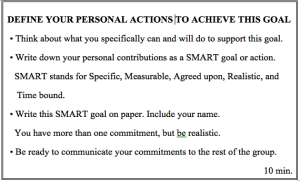“Sometimes I wish people would take responsibility for their own part in implementation. We have people from different areas of the organization in the room and I they would say what they will do to help us achieve our goals. Do you have any suggestions?”
#4: Individual Action Planning
What is Individual Action Planning?
Individual Action Planning is a simple technique for identifying individual commitments and contributions to the implementation of a goal.
In this process, each individual in the meeting group publicly states what he or she intends to do to support the newly agreed-upon goal. This Individual Action Plan communicates the specific commitments that each participant will undertake as their contribution to overall success.
When to Use Individual Action Planning
- When the individual contributions to a goal can be completed independently of each other
- When public commitment to a goal or action is key to increasing the effectiveness of implementation
How to Use Individual Action Planning
- After a goal or goals has been identified, introduce Individual Action Planning.
- Ask the participants in your meeting group to think about specifically what they will do to support that goal. Give everyone approximately ten minutes to write down their personal SMART Goals relative to the goal under consideration.
NOTE: Have participants write their goals on a piece of paper large enough to be seen from across the room.
Post an instruction chart similar to the one below to support you during Steps 1 and 2.
- Ask each individual to stand up, one by one, state their written commitments, and place them on a wall. Public commitment to a goal will enhance the likelihood that it is accomplished.
NOTE: Unless you are a neutral facilitator, remember to participate in the exercise along with everybody else.
OPTION: If your group is large or time is short, ask individuals turn to the person next to them to share their goals, or ask individuals a table to share their goals with the others at their table.
- Debrief the individual statements of commitment. You might ask, for example, “What are your reactions to what you have heard from your colleagues?” “How satisfied are you with the level of commitment from yourself and the others?” “How comfortable are you about the progress we will make if everyone honors their commitments?” “What might get in the way of your group achieving what you have committed to?” “What should be done to eliminate those road blocks?”
- Plan when and how to monitor progress. Visible follow up on progress and results will increase the likelihood that individuals will follow through on their commitments.
- Type up the commitments and send them out to the team after the meeting.
In Summary:
Individual Action Planning is a simple technique for identifying individual commitments and contributions to the successful implementation of a goal.
- After a goal or goals has been agreed, introduce the Individual Action Planning technique.
- Ask your participants to think about specifically what they will do to support that goal and give everyone approximately ten minutes to write down their personal SMART Goals or actions on pieces of paper.
- Have each participant stand up, one by one, state their commitments and put them on the wall in a pre-designated area.
- Debrief the individual statements of commitment.
- Plan when and how to monitor progress.
- Type up the commitments and send them out.
———————-
NOTE:
If you would like to receive e-mail notification when I post additional techniques, please sign up through this link. http://eepurl.com/KILan You may unsubscribe at any time.
You will find my book Mission Critical Meetings: 81 Practical Facilitation Techniques on Amazon. Your feedback and reviews are most welcome.
